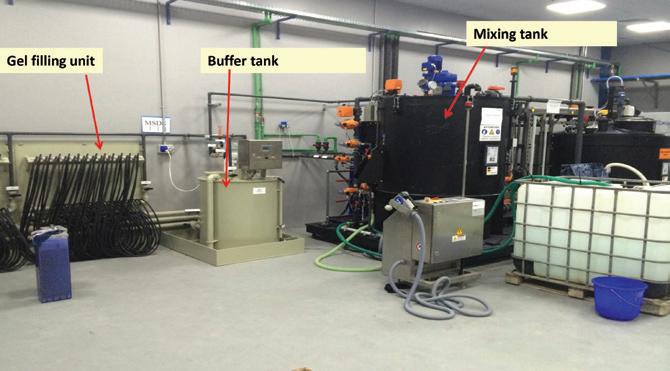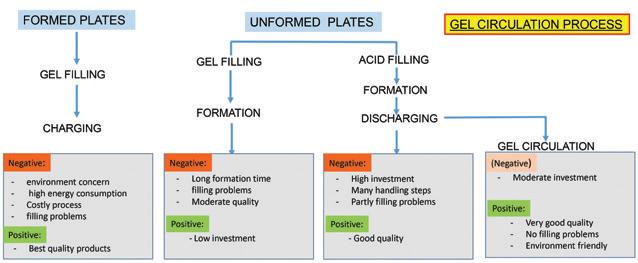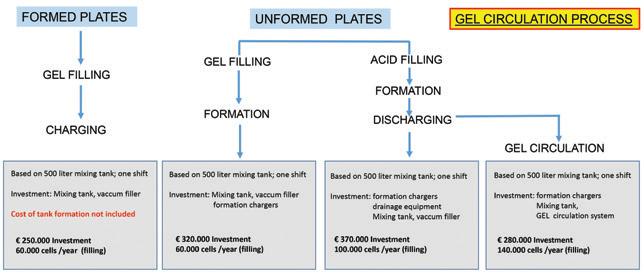
6 minute read
Abertax: A revolutionary new filling solution for gel batteries
from BCI Yearbook 2022
by hamptonhalls
Abertax, the Maltese specialist battery product developer, has come up with a new filling process for gel batteries that promises improvements in battery quality, an environmentally sensitive process and requires low investment.
A better gel formation process
Advertisement
Abertax’s innovation award submission is based on a new patented gel circulation process that does away with standard filling processes for gel batteries. The firm says it needs less investment in machinery, reduced production time and labour cost.
It is an environmentally friendly process — there is no acid wastage and much better quality/performance of such manufactured batteries. From the results so far, it seems that this system will be adopted as the standard by major gel battery manufacturers
“As soon as KD Merz the inventor, came up with this brilliant idea, Abertax, being a company encouraging such type of innovation, and environmentally conscious, supported his idea,” says a company spokesperson.
“We immediately completed an agreement with a third party company to build and install such systems to undergo field tests at a battery company, while applying for patent protection.”
Below follows a description of the traditional ways of gel filling with the Abertax method.
Direct gel filling (formed batteries).
The oldest method to fill lead acid batteries with gel is the filling of the silica/acid mixture into the batteries or cells having already formed plates. The gel is pre-prepared by a homogenous mixing of fumed silica (SiO2) with sulfuric acid having a silica concentration of around 6% and filled by a vacuum filling machine.
With suitable machines and equipment, a good and uniform gel filling can be achieved. However, there is always a risk, and in particular at higher temperatures, that the gel is jellifying quite fast inside the cells and can inhibit a complete, homogeneous and consistent coverage of the electrodes.
Such dry areas on the positive and/ or negative plates results in a loss of capacity and can cause premature failure.
Gel formation process
A low cost process is direct gel formation. After filling the gel into unformed cells or batteries a formation program is started. It sounds easy with no high investment in equipment, but the formation time is quite protracted — seven days or longer and needs a number of different charge and discharge steps.
Beside the very long formation time, the quality and performance of the finished product is not very good and this is one of the most expensive processes.
Two shot gel filling process
The batteries are formed with sulfuric acid. After formation the batteries are discharged to a level of 80% to 90%. The batteries are then turned upside down to drain the remaining low density acid from the battery. Shortly after the drainage, the batteries are filled with a prepared silica/acid mixture in the same acid density as the drained acid. Afterwards, the batteries need to be recharged.
This method of gel filling is the mostly used technology today, however, it has several disadvantages, such as: • If the waiting period after drainage of the acid and gel filling takes too long, the electrodes, in particular the negative plates can dry out and may cause filling problems. • Another negative point is to achieve a good homogenous gel distribution inside the cells. • In particular in block batteries where the lid design causes acid to accumulate when the battery is turned upside down to drain the acid.
The Abertax gel circulation process
This new method introduced in the gel technology production of VRLA batteries follows the two shot gel filling process up to the formation step. The idea is to transform the liquid inside the cells into gel without the draining process.
This is done by a novel circulation process which circulates the liquid in the formed cells while adding the silica in the process in a gradual way until the perfect gel mixture is achieved in the cells.
After the formation, the cells are simply connected to the proposed gel circulation system and the controlled process is initiated until the right acid/silica concentration is reached.
KD MERZ
KD Merz is the vice-president for technology at Abertax Technologies and is also a council member, where, in parallel, he is also involved in research and development work on VRLA Battery improvements.
The first step is the preparation of the gel/acid mixture in the mixing tank. The acid specific gravity and the silica content of this mixture depends on the conditions of the cells after the formation followed by an electrical discharge process to lower the acid specific gravity.
The specific gravity of the acid in the mixing tank is set to be the same level as the acid specific gravity in the discharged formed cells.
The silica content is calculated based on the electrolyte exchange volume and the required (final) silica content in the cells.
After the gel/acid tank mixture is completed (homogeneity can be tested with the syringe test), this thixotropic dispersion is ready for the circulation filling process.
The formed and discharged cells are connected to the gel circulation unit and the gel circulation is started by activating the pump in the mixing unit.
The process will stop when the silica mixture in the tank and cells ends up to be 12%.
The time of the whole circulation process depends on the overall volume of the acid which needs to be replaced in the cells. In an example of 150 litres it will take about 38 minutes.
Right after the completion of gel circulation, the cells/batteries are disconnected from the unit and prepared for a recharge. The charging regime should be of a regulated IU or IUI regime with a voltage limit during the U phase of 2.45 vpc.
From the numerous and regular quality checks done over the production lines in the past two years, it is evident that apart from an economic and cost efficient gel filling process, much better quality cells are produced using the Abertax gel mixing process.

Gel Mixing and Circulation System — Actual Installation

Gel Filling Processes (Comparison)

Gel Filling Processes investment and efficiency
ADVANTAGES
Apart from offering excellent good performance and quality results, this new, patent-protected and innovative process for the filling of gel batteries, offers several remarkable advantages both financially and environmentally.
The avoidance of draining the cells in the commonly used two shot process has itself a huge impact. This offers a huge reduction in time on the overall process, no acid dumping with its risks and consequences, much less labour intensive, avoid exposure of the plates to air, and above all the elimination of possible air pockets while filling.
The battery lifetime is optimized hence reducing the recycling frequency and its related environmental impact and ensuring that guarantee claims due to filling problems is eliminated.
When considering a new gel filling system the capital investment using this method is cheaper and occupies less space when compared to the other methods especially the two-shot method as no drainage equipment and vacuum system are required.










